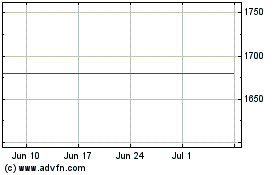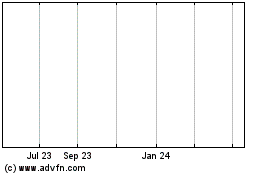Huawei Slips to No. 2 in Smartphones as Samsung Reclaims Lead
October 30 2020 - 9:33AM
Dow Jones News
By Dan Strumpf
Huawei Technologies Co.'s reign at the top of the global
smartphone market was short-lived, a sign that U.S. efforts to curb
its supply chain might be starting to hurt the Chinese company.
The Shenzhen-based tech giant fell to second place in global
smartphone shipments during the third quarter of the year, slipping
back behind Samsung Electronics Co., according to International
Data Corp., a market research firm. Huawei's world-wide shipments
fell by 22% in the third quarter, the largest year-over-year drop
in smartphone shipments for the company on record, according to
IDC. Huawei had climbed to No. 1 in the previous quarter.
The decline is an indication that the U.S. restrictions on sales
of chips and other components to Huawei are taking a toll on
Huawei's consumer-gadget business, the company's largest source of
revenue. Virtually all component vendors without a license from the
U.S. Commerce Department have been effectively blocked from selling
parts to Huawei since Sept. 15, forcing the Chinese company to rely
on stockpiled components to build its devices.
Overseas buyers have been turning away from Huawei devices this
year -- partly due to the economic toll wrought by the coronavirus
pandemic outside of China, but also because U.S. restrictions mean
its devices can no longer run Google's popular smartphone apps.
Huawei's smartphone sales had been buoyed by a buying spree in
China, but recently, even its domestic performance has been
suffering: Sales fell more than 15% in the third quarter, according
to IDC.
Huawei has been slowing down its distribution of devices to
stores, so as not to run down its inventory too soon, said Will
Wong, an analyst at IDC, citing its research into distribution
networks.
"What we're seeing is that they intentionally slowed down their
pace," Mr. Wong said, "If they can last longer in the market, this
can give confidence to consumers and to the supply chain as
well."
A Huawei spokesman disputed IDC's conclusion, saying that the
company isn't deliberately slowing phone shipments.
"Huawei is actively fulfilling its channel orders normally," the
spokesman said. "Any suggestion that we are restricting channel
supply is misinformed."
The company has repeatedly denied U.S. assertions that the
company's products pose a national-security threat, the reason
cited by the Trump administration for targeting Huawei.
Huawei executives have warned that restrictions imposed by the
Trump administration this year on the company's ability to buy
chips and other parts pose a threat to its business. Guo Ping,
Huawei's deputy chairman, last month said, "Survival is the
goal."
To be sure, quarterly shipment data offers only a limited window
into company performance, and smartphone sales fluctuate throughout
the year.
Earlier this month, the company unveiled its latest flagship
product, the Mate 40, which it expects to boost demand. The company
has said that it would likely be the last device to be sold with
its self-designed Kirin chip, and executives said that the company
is looking for solutions to the shortfalls in its smartphone supply
chain.
Several chip suppliers have revealed that they have applied for
licenses from the Commerce Department to resume shipments to
Huawei, and a small number have received them, according to people
familiar with the matter. Among them, Samsung's display
manufacturer received approval from the U.S. to sell certain types
of smartphone panels to Huawei, according to a person familiar with
the matter.
Other parts suppliers disclosed a bump in sales to Huawei in the
period leading up to Sept. 15, as the company stockpiled chips and
other parts. A Samsung executive told investors on Thursday that
the company saw "urgent orders" placed by Huawei in the third
quarter, boosting sales.
The company was still the No. 1 vendor in China in the latest
quarter, with more than 40% of the overall market, according to
Canalys, which released data also on Friday.
Write to Dan Strumpf at daniel.strumpf@wsj.com
(END) Dow Jones Newswires
October 30, 2020 09:18 ET (13:18 GMT)
Copyright (c) 2020 Dow Jones & Company, Inc.
Samsung Electronics (PK) (USOTC:SSNHZ)
Historical Stock Chart
From Mar 2024 to Apr 2024

Samsung Electronics (PK) (USOTC:SSNHZ)
Historical Stock Chart
From Apr 2023 to Apr 2024
